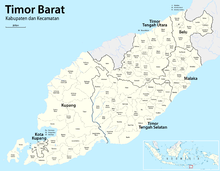Insana
Insana is a traditional kingdom ( Indonesian kerajaan ) in what is now the administrative district ( Indonesian kabupaten ) of North Central Timor (Timor Tengah Utara) in the Republic of Indonesia . The residence of the Rajas of Insana is still today in Oelolok , the administrative seat of the modern district ( Indonesian kecamatan ) Insana .
history
Insana was one of the empires who, as a vassal of Wehale , placed themselves under the sovereignty of the Dutch East India Company (VOC) with the Treaty of Paravicini in 1756 .
The Taolin dynasty was originally the executive power under the ruler of Insana, the "emperor" ( Dutch Keser ) of the Usfinite dynasty, who took on the legislative and symbolic tasks. Since the Dutch could not do much with what they saw as a powerless ruler, they made the Taolin the sole rulers of Insana, with the title of Rajas. After the Dutch colonial period, Insana became part of the Indonesian West Timor. In the early 1960s, the traditional monarchies in Indonesia were abolished. The Raja Lorencius Taolin then became Camat , the administrative chief of the Insana district . Later his son Theodorus Taolin took over the office. He remained Camat until 1991 when his father died. Then Theodorus took over the symbolic office of Rajas, later he became vice-president of the local parliament. His younger brother Eddy Taolin became the new Camat. The son of Theodorus Gaspar Taolin is considered the hereditary prince for the Raja title.
A son of Lorencius Taolin was Louis Taolin , agent of the Bakin military secret service. Taolin was a key figure in Operation Komodo to annex East Timor. One of Louis' uncle was El Tari , provincial governor of Nusa Tenggara Timur .
Insana today
Today Insana is administratively divided into the five districts Insana, Insana Fafinesu , Nordinsana (Insana Utara) , Westinsana (Insana Barat) and Central Insana (Insana Tengah) .
The region is known for its special Ikat -Substances ( Tais known) and traditional dance.
residence
The Taolin residence, the Lanesu Palace (Sonaf Lanesu) in Oelolok is considered culturally valuable. Raja Lorencius Taolin was a patron of dance and sculpture, which can be seen in the palace. The garden is divided into four parts, one each for the four clans (Amaf) of Insana: Hitu, Taboy, Saijo and Banusu. There are also graves of the ruling family on the area.
Ruler of Insana
The ruling family, like most of the population of West Timor, belongs to the Atoin Meto ethnic group .
- Tana Mende (1761)
- Taku (1765)
- Malafu Neno
- Malafu Pa (son)
- Malafu Tasaeb (1880–1901) (son)
- Usi Nila (Nila Ela Taiboko) (1902-1914)
- Kahalasi Taolin (1915-1934)
- Tasaeb Malafu (1934–1936) (great-grandson of Malafu Tasaeb)
- Afu Tasaeb (1936–1938) (son)
- Dominicus Taolin (1938–1940; died 1974) (son of Kahalesi Taolin)
- Petrus Atolan Tasaeb (1940–1942; died 1989) (grandson of Tasaeb Malafu)
- Lorencius Taolin (1942–1962; * August 10, 1914, † February 10, 1991) (brother of Dominicus Taolin)
- Theodorus (Olis) Taolin (son of Lorencius Taolin)
Web links
Individual evidence
- ↑ a b c Royal Timor: Sonbai ( Memento from July 15, 2011 in the Internet Archive )
- ↑ Hans Hägerdal: Servião and Belu: Colonial conceptions and the geographical partition of Timor (PDF file; 338 kB)
- ↑ Sultans of Indonesia: Kingdom of Insana - Timor , accessed on November 19, 2017.
- ^ A b David Hicks: Rhetoric and the Decolonization and Recolonization of East Timor. Routledge, 2015, p. 229 limited preview in Google Book search.
- ↑ Indonesia Kaya: Wujud Apresiasi Kain Ikat dalam Tari Sandang Insana , (Indonesian), accessed on November 19, 2017.
- ^ Sultans of Indonesia: Kingdom of Insana - Timor (Indonesian), accessed November 19, 2017.
- ^ Schulte Nordholt, HG: The Political system of the Atoni of Timor. , Pp. 212-215 The Hague 1971.
- ^ Truhart, Peter: Regents of Nations , p. 1327, Part 3, Asia & Pacific Oceania. Munich 2003.
- ↑ Taniputera, Ivan: Kerajaan-kerajaan Nusantara pascakeruntuhan Majapahit , pp. 1406–1411, 1624–1625, Jakarta 2013.
Coordinates: 9 ° 28 ' S , 124 ° 42' E

